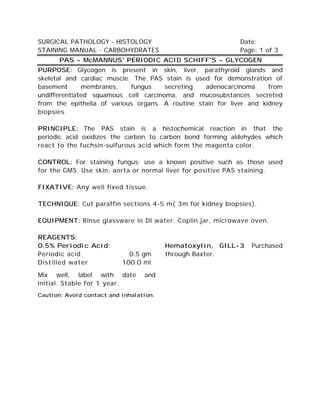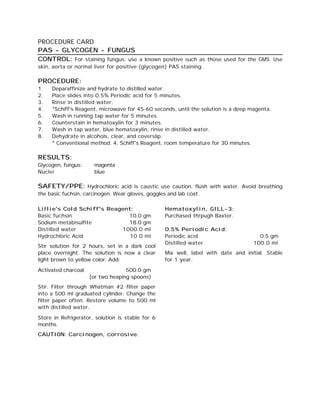Pas
- 1. SURGICAL PATHOLOGY - HISTOLOGY Date: STAINING MANUAL - CARBOHYDRATES Page: 1 of 3 PAS - McMANNUS' PERIODIC ACID SCHIFF'S - GLYCOGEN PURPOSE: Glycogen is present in skin, liver, parathyroid glands and skeletal and cardiac muscle. The PAS stain is used for demonstration of basement membranes, fungus secreting adenocarcinoma from undifferentiated squamous cell carcinoma, and mucosubstances secreted from the epithelia of various organs. A routine stain for liver and kidney biopsies. PRINCIPLE: The PAS stain is a histochemical reaction in that the periodic acid oxidizes the carbon to carbon bond forming aldehydes which react to the fuchsin-sulfurous acid which form the magenta color. CONTROL: For staining fungus; use a known positive such as those used for the GMS. Use skin, aorta or normal liver for positive PAS staining. FIXATIVE: Any well fixed tissue. TECHNIQUE: Cut paraffin sections 4-5 m( 3m for kidney biopsies). EQUIPMENT: Rinse glassware in DI water. Coplin jar, microwave oven. REAGENTS: 0.5% Periodic Acid: Hematoxylin, GILL-3 Purchased Periodic acid 0.5 gm through Baxter. Distilled water 100.0 ml Mix well, label with date and initial. Stable for 1 year. Caution: Avoid contact and inhalation.
- 2. CARBOHYDRATES PAS STAIN Page: 2 of 3 Lillie's Cold Schiff's Reagent: Basic fuchsin 10.0 gm Sodium metabisulfite 18.0 gm Distilled water 1000 0 ml Hydrochloric acid 10.0 ml Stir solution for 2 hours, set in a dark cool place overnight. The solution is now a clear light brown to yellow color. Add: Activated charcoal 500.0 gm (or two heaping spoons) Stir. Filter through Whatman #2 filter paper into a 1000 ml graduated cylinder. Change the filter paper often. Restore volume to 1000 ml with distilled water. Store in Refrigerator, solution is stable for 6 months. CAUTION: Carcinogen, corrosive. SAFETY: Wear gloves, goggles and lab coat. Avoid contact and inhalation. Hydrochloric acid: strong irritant to skin, eyes and respiratory system. Target organ effects via inhalation on skin, respiratory, reproductive and fetal systems. Corrosive. SchiffŌĆÖs Reagent: Use extreme caution, Basic fuchsin (pararosaniline) is a known carcinogen. Wear gloves, goggles, particle mask and lab coat, while preparing solution. Work under the hood, keep hot, uncapped, solutions under the hood.
- 3. CARBOHYDRATES PAS STAIN Page: 3 of 3 PROCEDURE: 1. Deparaffinize and hydrate to distilled water. 2. Place slides into 0.5% Periodic acid for 5 minutes. 3. Rinse in distilled water. 4. *Schiff's Reagent, microwave HIGH power, for 45 - 60 seconds, until deep magenta. 5. Wash in running tap water for 5 minutes. 6. Counterstain in hematoxylin for 3 minutes. 7. Wash in tap water, blue hematoxylin, rinse in distilled water. 8. Dehydrate in alcohol, clear, and coverslip. * Conventional method: Schiff's Reagent, room temperature for 30 minutes. RESULTS: Glycogen, fungus: magenta Nuclei blue NOTES: 1. To check stain, pour 10 ml of formaldehyde in cylinder, add a few drops of Schiff's, it should turn red-purple immediately. 2. Discard Schiff's if it turns pink while sitting in the refrigerator. 3. The white precipitate at the bottom of the Schiff's can be re- dissolved if desired by gently warming and stirring the solution. REFERENCES: Sheehan D, Hrapchak B, Theory and practice of Histotechnology, 2nd Ed, 1980, pp 164-166, Battelle Press, Ohio Bancroft J, Stevens A, Theory and Practice of Histological Techniques, 2nd Ed, 1982, pp 188-190, Churchill Livingstone, NY Crookham, J, Dapson, R, Hazardous Chemicals in the Histopathology Laboratory, 2nd ED,1991, Anatech Prepared: By: Approved: By: Downloaded from WebPath: Internet Pathology Laboratory http://www-medlib.med.utah.edu/WebPath/webpath.html
- 4. PROCEDURE CARD PAS - GLYCOGEN - FUNGUS CONTROL: For staining fungus; use a known positive such as those used for the GMS. Use skin, aorta or normal liver for positive (glycogen) PAS staining. PROCEDURE: 1. Deparaffinize and hydrate to distilled water. 2. Place slides into 0.5% Periodic acid for 5 minutes. 3. Rinse in distilled water. 4. *Schiff's Reagent, microwave for 45-60 seconds, until the solution is a deep magenta. 5. Wash in running tap water for 5 minutes. 6. Counterstain in hematoxylin for 3 minutes. 7. Wash in tap water, blue hematoxylin, rinse in distilled water. 8. Dehydrate in alcohols, clear, and coverslip. * Conventional method: 4. Schiff's Reagent, room temperature for 30 minutes. RESULTS: Glycogen, fungus: magenta Nuclei blue SAFETY/PPE: Hydrochloric acid is caustic use caution, flush with water. Avoid breathing the basic fuchsin, carcinogen. Wear gloves, goggles and lab coat. Lillie's Cold Schiff's Reagent: Hematoxylin, GILL-3: Basic fuchsin 10.0 gm Purchased thrpugh Baxter. Sodium metabisulfite 18.0 gm Distilled water 1000.0 ml 0.5% Periodic Acid: Hydrochloric Acid 10 0 ml Periodic acid 0.5 gm Distilled water 100.0 ml Stir solution for 2 hours, set in a dark cool place overnight. The solution is now a clear Mix well, label with date and initial. Stable light brown to yellow color. Add: for 1 year. Activated charcoal 500.0 gm (or two heaping spoons) Stir. Filter through Whatman #2 filter paper into a 500 ml graduated cylinder. Change the filter paper often. Restore volume to 500 ml with distilled water. Store in Refrigerator, solution is stable for 6 months. CAUTION: Carcinogen, corrosive.
- 5. 0.5% PERIODIC ACID: LILLIE'S COLD SCHIFF'S REAGENT: Periodic acid 0.5 gm Basic fuchsin 10.0 gm Distilled water 100.0 ml Sodium metabisulfite 18.0 gm Distilled water 1000.0 ml Mix well, label with date and Hydrochloric acid 10.0 ml initial. Stable for 1 year. Stir solution for 2 hours, set in a CAUTION: Avoid contact and inhalation. dark cool place overnight. The DATE: solution is now a clear light brown to yellow color. Add: TECH: Activated charcoal 500.0 gm (or two heaping spoons) EXPIRATION: Stir. Filter through Whatman #2 0.5% PERIODIC ACID filter paper into a 1000 ml graduated cylinder. Change the DATE: filter paper often. Restore volume to 1000 ml with distilled water. TECH: Store in Refrigerator, solution is stable for 6 months. CAUTION: Carcinogen, corrosive. DATE: TECH: EXPIRATION: SCHIFF'S SOLUTION DATE: TECH:





